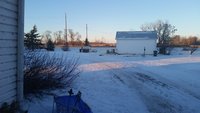Anethema
Chirping
Hey everyone.
I'm in Northern Canada and after a -40(f/c same) cold snap, I've found my 2 roosters and 1 hen with a bigger comb has some pretty bad frostbite.
From doing some reading I don't have proper ventilation.
The coops are 8x12' and have a 7 foot high ceiling which I believe is insulated (I didn't build the coops). The eaves are fully open except for wire, but those only open to the 'attic'
The ceiling has a few like 1"x4' slits where the paneling that makes it didn't fully overlap but that is essentially all the contact the main room has with the ventilated attic.
So obviously I don't have near enough ventilation.
The question now is: What do I do ?
Should I just rip the ceiling right out so they have the open eaves? Should I cut ventilation holes in the main room at the ceiling level? Is -40 too cold without some kind of heat (in addition to needing the ventilation of course)?
I'll snap some pics shortly to give everyone a better idea.
EDIT: Here is an album https://imgur.com/gallery/cY61i
Thanks!
I'm in Northern Canada and after a -40(f/c same) cold snap, I've found my 2 roosters and 1 hen with a bigger comb has some pretty bad frostbite.
From doing some reading I don't have proper ventilation.
The coops are 8x12' and have a 7 foot high ceiling which I believe is insulated (I didn't build the coops). The eaves are fully open except for wire, but those only open to the 'attic'
The ceiling has a few like 1"x4' slits where the paneling that makes it didn't fully overlap but that is essentially all the contact the main room has with the ventilated attic.
So obviously I don't have near enough ventilation.
The question now is: What do I do ?
Should I just rip the ceiling right out so they have the open eaves? Should I cut ventilation holes in the main room at the ceiling level? Is -40 too cold without some kind of heat (in addition to needing the ventilation of course)?
I'll snap some pics shortly to give everyone a better idea.
EDIT: Here is an album https://imgur.com/gallery/cY61i
Thanks!
Last edited:


 You're really going to bring me into this discussion??
You're really going to bring me into this discussion?? 
 They are the subordinate roosters.
They are the subordinate roosters.
 I think with 3 winters under my belt I can say this with confidence now.
I think with 3 winters under my belt I can say this with confidence now.



 I can't handle the heat. Please DON'T make me go to Mexico. We can get as hot as 35 C in the summer. I'm still in a t-shirt in the yard in -15 C weather to grab something quick. It's currently -28 C right now...and I'm only wearing a sweater to go out to go home. (We're supposed to get down to -31 tonight.) That's just life here.
I can't handle the heat. Please DON'T make me go to Mexico. We can get as hot as 35 C in the summer. I'm still in a t-shirt in the yard in -15 C weather to grab something quick. It's currently -28 C right now...and I'm only wearing a sweater to go out to go home. (We're supposed to get down to -31 tonight.) That's just life here.
 I have no experience with -40
I have no experience with -40